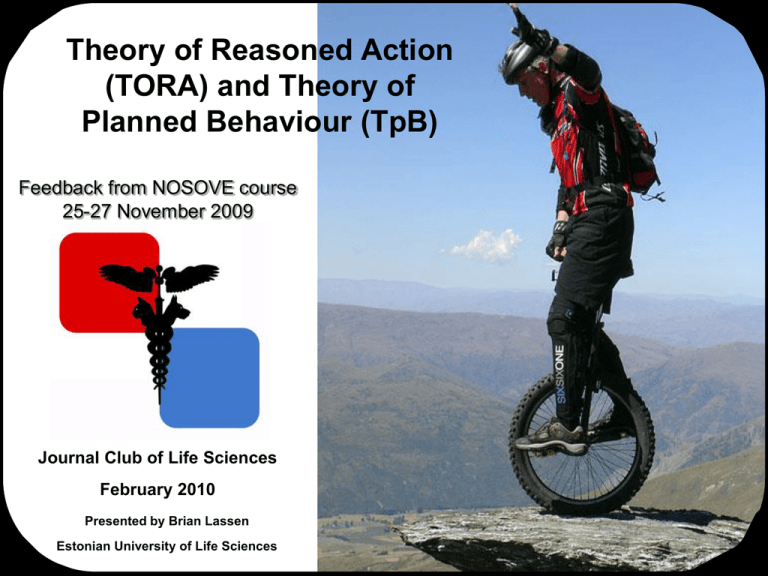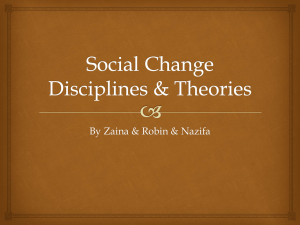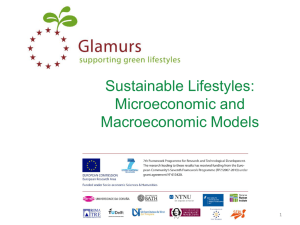presentation
advertisement

Theory of Reasoned Action Theory of Reasoned Action (TORA) and Theory of(TORA) and Theory of Planned Behaviour Planned Behaviour (TpB) Feedback from NOSOVE course 25-27 November 2009 Uppsala, Sweden Journal Club of Life Sciences February 2010 Presented by Brian Lassen Estonian University of Life Sciences Climate Change and the Potential Range History Expansion of the Lyme Disease Vector Ixodes First introduction: scapularis in Canada Fishbein (1967): Readings in Attitude Theory and Measurement Formalised: Fishbein and Aijzen (1975): Belief, Attitude, Intention and Behaviour: An introduction to Theory and Research Definitive book: Aijzen and Fishbein (1980): Understanding Attitudes and Predicting Social Behaviour From presentation by Chris Garfoth Climate What Change and the Potential Range is TORA and TpB? Expansion of the Lyme Disease Vector Ixodes Statistical model thatscapularis use quenstionnaires to find correlation between in Canada explained intents and beliefs and actual behavior. Who use TORA and TpB? • Economists (agricultural economics, marketing) • Sociology (rual sociology) • Antropology • Psycology • Social Psycology • Medicine • Veterinary Sciences From presentation by Chris Garfoth What can TORA and TpB be used for? Adressing questions: - About welfare • Standard of living • Poverty (how to measure it, what causes it, comparing between people) • What effect does different policies have on welfare? Adressing behaviour • Why do people behave the way they do? • How do other people influence the way we behave? • What type of farmers are likely to adopt new technology/advice From presentation by Chris Garfoth Key assumptions in TORA „Human behavior is rational“ „Human behaviours have a common structure and can therefore be predicted“ „Explaining any human behaviour requires examining determinant of intentions: attitudes and beliefs.“ From presentation by Chris Garfoth Theory of Reasoned Action (TORA) Behavioural Beliefs bs Normative Beliefs nb Attitude Towards Subjective the Norm Behaviour mc oe B = γ1Σbsioei + γ2Σnbjmej Behaviour (B) = Behaviour intent bs = belief strength (behaviour → outcome?) oe = outcome evaluation (good/bad) nb = normative beliefs (should/should not) mc = motivation to comply (willingness) Intention Behaviour Copyright © Icek Azin 2002 Theory of Planned Behaviour (TpB) Behavioural Beliefs bs Normative Beliefs nb Control Beliefs cb Attitude Perceived Towards Subjective Behavioral the Norm Control Behaviour mc oe pb B = γ1Σbsioei + γ2Σnbjmej + γ3Σcbkpbk Behaviour (B) = Behaviour intent bs = belief strength (behaviour → outcome?) oe = outcome evaluation (good/bad) nb = normative beliefs (should/should not) mc = motivation to comply (willingness) cb =control belief (belief → change behaviour) pb = power of control belief (subjective evaluation of cause → effect) Intention Behaviour Copyright © Icek Azin 2002 Theory of Planned Behaviour (TpB) Behavioural Beliefs bs Normative Beliefs nb Control Beliefs cb Attitude Perceived Towards Subjective Behavioral the Norm Control Behaviour mc oe pb Intention Behaviour Actual Behaviour Control B = γ1Aact + γ2SN + γ3PBC Behaviour (B) = Behaviour intent Aact = Attitude – postitive/negative evaluation of performing behaviour SN = Subjective Norm – persons perception of the social pressures on him/her to/not to perform behaviour PBC = Percieved behavioural control – pervieved ease/difficulty of performing a behavour Follow up control after initial questionnaire: Actual Behaviour Control – correlation between stated intent and actual intent. Copyright © Icek Azin 2002 Example of phrasing a question for TORA Behaviour being examined: Using disinfectant to prevent disease in pigs when cleaning Action in question: Disinfecting Target of question: Disinfectant Context in which to view question: Cleaning living areas for pigs Important to avoid changes in behaviour over time Time: Within monthly hygiene practices Examples of TORA questions Behavioural Beliefs and Attitude towards Behaviour Intention of behaviour (bs): „How strong is your intention to strictly follow the Ministry of Agricultures recommended guidelines regarding disinfection of pigs pens during the next year?“ Very strongly (+2), Strongly (+1), Undecided (0), Not so strong (-1), No intention (-2) Behavioural Beliefs bs Attitude Towards the Behaviour oe Emotive measure (oe): „In your opinion how good or bad would it be to strictly follow the Ministry of Agricultures recommended guidelines regarding disinfection of pigs pens during the next year?“ Very good (+2), good (+1), Don't know (0), bad (-1), very bad (-2) Calculated attitude = intention of behaviour (bs) x emotive measure (oe) Value: 4 to -4 Examples of TORA questions Subjective Norm The stated subjective norm: „Would people who you respect in the farming industry be supportive or opposed if you adopted the Ministry of Agricultures recommended guidelines regarding disinfection of pigs pens during the next year?“ Normative Beliefs nb Subjective Norm Very supportive (+2), supportive (+1), Don't know (0), opposed (-1), very opposed (-2) The calculated subjective norm (nb): mc „How strongly do you feel the would agree with your veterinarian in adopted the Ministry of Agricultures recommended guidelines regarding disinfection of pigs pens during the next year?“ Strongly agree (+2), agree (+1), Don't know (0), diagree (-1), strongly disagree (-2) Motivation to comply (mc): „How strongly motivated would you be to comply with your veterinarian if he/she ask you to strictly follow the Ministry of Agricultures recommended guidelines regarding disinfection of pigs pens during the next year?“ Very motivated (+2), motivated (+1), Don't know (0), not very motivated (-1), not at all motivated (-2) Motivation to comply = normative belief (nb) x motivation to comply (mc) Value: 4 to -4 Behavioural Beliefs Attitude Towards the Behaviour bs Statistical application (TORA) nb Spearman coefficient correlations (r) mc oe In example Subjective norm is more important than the attitude Attitude sb x oe Mean: 3.78 Range (+36 to -36) r=0.261 (*) Ranked influenceal „drivers“ • Cost effective (range +4 to -4) (***) • Improve mortality rates (range +4 to -4) (***) • Improve health (range +4 to -4) (***) • Effective for all ages (range +4 to -4) (**) Intention Normative Beliefs Subjective Norm Subjective Norm nb x mc Mean: 0.36 Range (+2 to -2) r=0.343 (***) Mean: -0.66 Range (+2 to -2) One significant subjective norm r=0.387 (***) Behaviour Mean: 0.36 Range (0 to 1) From presentation by Chris Garfoth Application of questions Survey questionnaires 1. Answerable in 15 minutes 2. Behaviours addressed kept to a minimum of 3 3. Keep the number of referents and outcome beliefs to a manageable number 4. Stated subject norm should only be applied to specific behaviours 5. Pay particular attention to the layout of the questionnaire. Running veterinary research with TORA DAHREVA A study aiming to improve the health recording systems. Assessment of the validity of the dairy health recording systems in the Nordic countries (funding: NKJ – 127), * PhD students Cecilia Wolff – Sweden Mari Espetvedt – Norway Simo Rintakoski – Finland Ann-Kristina Lind - Denmark Thank you Next Journal Club... 18 March, 13:00 Toiv Haljasorg: Mass spectrometry and applications in science






